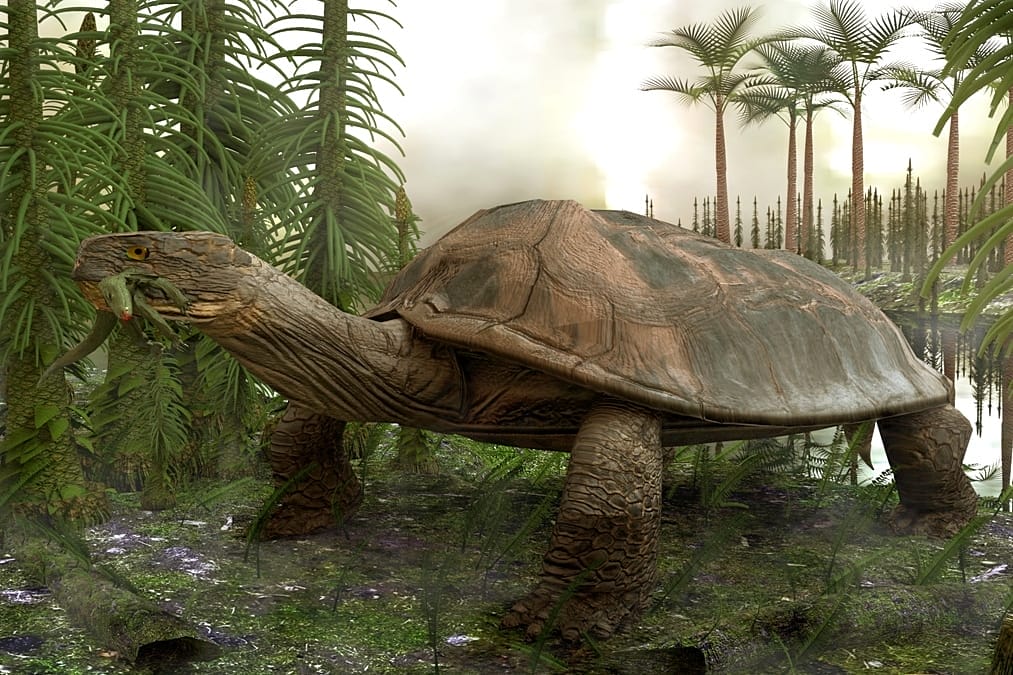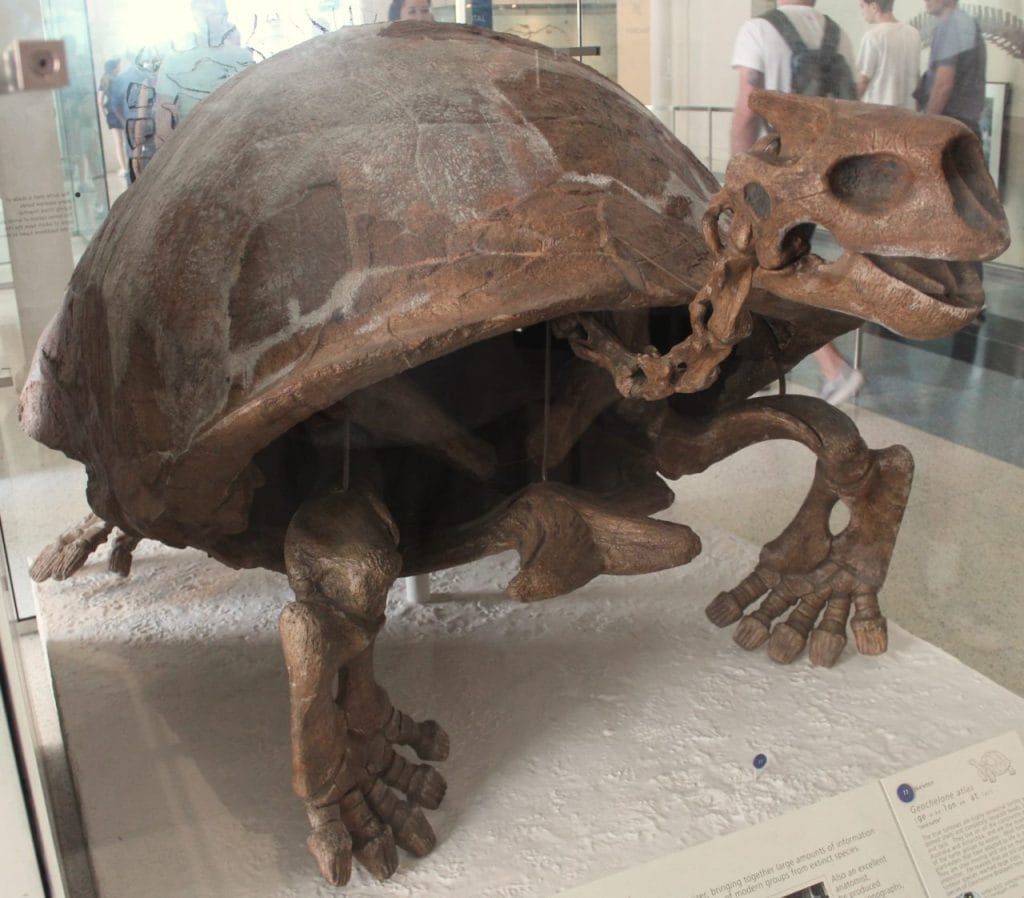24 Prehistoric Turtle Species: Giants of the Ancient World

This post was created with help from AI tools and carefully reviewed by a human (Muntaseer Rahman). For more on how we use AI on this site, check out our Editorial Policy.
Turtles have been around for more than 200 million years. That means they outlived the dinosaurs, survived mass extinctions, and still swim, crawl, and chill in the sun today.
Some prehistoric turtles were as big as cars. Others had spikes, sharp jaws, or even teeth. Let’s dive into their wild history!

The Earliest Turtles (Triassic Period: 250–200 MYA)
The first turtles looked nothing like the cute ones we see today. They were armored, couldn’t pull their heads into their shells, and some even had teeth.
Some of the earliest turtles:
| Name | Fun Fact |
|---|---|
| Proganochelys | Had spikes all over its body for defense |
| Palaeochersis | Couldn’t retract its head but had a strong shell |
| Odontochelys | Had teeth instead of a beak, making it a weird turtle-lizard mix |
Most modern turtles can tuck their heads inside their shells when danger appears. But early turtles like Proganochelys had no such trick. Instead, they relied on their spiked armor to scare away predators.
Odontochelys, on the other hand, looked like a turtle still figuring things out. It had a partial shell, a long tail, and—unlike modern turtles—actual teeth! Imagine a snapping turtle, but with an even nastier bite.

Warning: You Might Spend Hours Here
I’ve built the ultimate turtle and tortoise species database. This isn’t your average turtle list. Filter by genus, conservation status, and more. How many species? Which are endangered? What’s the tiniest one? It’s all there.
Jurassic Turtles: The First Marine Explorers (200–145 MYA)
During the Jurassic period, turtles started exploring the water more. Some of the first marine turtles appeared, adapting to life in lakes, rivers, and oceans.
Famous Jurassic turtles:
- Kayentachelys – One of the first North American turtles. Still figuring out if it liked land or water.
- Eileanchelys – An early swimmer, proving that turtles were made for the ocean.
- Condorchelys – A South American turtle showing early signs of marine life.
By the Jurassic, turtles had a choice: stay on land or dive into the water. Some, like Kayentachelys, were caught in between—semi-aquatic and still deciding where they belonged. Others, like Eileanchelys, went full ocean mode, developing streamlined bodies perfect for swimming.
I always wondered what the first turtle to jump into the ocean must have thought. Maybe something like: “Wait… this is awesome!”

This Hilarious Turtle Book Might Know Your Pet Better Than You Do
Let’s be real—most turtle care guides feel like reading a textbook written by a sleep-deprived zookeeper.
This one’s not that.
Told from the snarky point of view of a grumpy, judgmental turtle, 21 Turtle Truths You’ll Never Read in a Care Guide is packed with sarcasm, sass, and surprisingly useful insights.
And hey—you don’t have to commit to the whole thing just yet.
Grab 2 free truths from the ebook and get a taste of what your turtle really thinks about your setup, your food choices, and that weird plastic palm tree.
It’s funny, it’s honest, and if you’ve ever owned a turtle who glares at you like you’re the problem—you’ll feel seen.
Cretaceous Giants: When Turtles Ruled the Seas (145–66 MYA)
Now we’re talking giants. The Cretaceous period had massive sea turtles that ruled the oceans alongside mosasaurs and sharks.

Some of the biggest turtles ever:
| Name | Size | Fun Fact |
|---|---|---|
| Archelon | 4 meters (13 feet) long | Biggest turtle ever, larger than a car |
| Protostega | Slightly smaller than Archelon | Still huge, with a lightweight shell |
| Toxochelys | Small compared to Archelon | One of the first true sea turtles |
| Santanachelys | Early sea turtle | Couldn’t fully retract its flippers |
This was the golden age of giant sea turtles. Archelon was the king of them all. With a shell longer than a human, it was bigger than a great white shark. If it were alive today, it would make modern sea turtles look like babies.

Other cool Cretaceous turtles included:
- Bothremys – A freshwater turtle found in multiple continents.
- Desmatochelys – A fast-swimming marine turtle.
- Ctenochelys – An early ancestor of modern sea turtles.
Archelon and its relatives didn’t need to worry about predators much, except for huge marine reptiles like mosasaurs. Even then, their size alone made them tough to mess with.
Post-Dinosaur Era: The Titans of Freshwater (66–2.6 MYA)
When the dinosaurs disappeared, turtles kept thriving. Some of them grew even bigger, especially in rivers and lakes.

The biggest freshwater turtles:
| Name | Size | Fun Fact |
|---|---|---|
| Stupendemys | 3 meters (10 feet) long | The largest freshwater turtle ever |
| Carbonemys | Gigantic | Could bite through crocodile bones |
| Gigantochelys | Huge land tortoise | Related to modern giant tortoises |
Most people think of giant turtles as slow, peaceful creatures, but not Carbonemys. This prehistoric monster had a jaw powerful enough to crush bones. It lived in South America and even hunted crocodiles.
Stupendemys, on the other hand, was all about size. Its shell alone was as long as a full-grown human. If you ever went swimming in its territory, you’d probably see a massive shadow beneath you—terrifying but also kind of cool!

Other turtles from this era:
- Honeymys – Strong-jawed prehistoric turtle.
- Puentemys – Had a perfectly round shell like a shield.
- Basilemys – A heavily armored land turtle.
- Adocus – A softshell-like turtle from the Cretaceous.
- Erquelinnesia – A tough turtle that survived dinosaur extinction.

Why Did These Turtles Go Extinct?
Some of these turtles lived for millions of years, but they eventually disappeared. Why?
- Climate changes – Some turtles couldn’t handle the cold.
- New predators – Crocodiles, giant fish, and even mammals started hunting them.
- Competition – Modern turtles evolved and outcompeted their giant ancestors.
Imagine being a turtle the size of a dining table and suddenly, the world gets colder. Food disappears, and new predators arrive. That’s exactly what happened to many prehistoric turtles.

Some, like Erquelinnesia, managed to survive for a while. But eventually, the smaller, faster, and more adaptable turtles took over.
Luckily, their relatives are still around today. Every time you see a sea turtle or a giant tortoise, remember—they had prehistoric cousins that were way bigger, meaner, and stronger.
Final Thoughts: Turtles Are Survivors
Turtles have survived everything—asteroids, ice ages, and even us humans messing with their habitats. They’ve been around for over 200 million years, and they’re not stopping anytime soon.
Next time you see a turtle, just think… it might have the blood of a dinosaur-era giant in its veins. Now, that’s cool.
Would you want one of these prehistoric turtles as a pet? I bet feeding a crocodile-eating turtle would be a nightmare!

About Author
Muntaseer Rahman started keeping pet turtles back in 2013. He also owns the largest Turtle & Tortoise Facebook community in Bangladesh. These days he is mostly active on Facebook.











